コラム
落合憲弘
John Sypal
タカザワケンジ
なぎら健壱

This week, instead of focusing on a particular Tokyo book I’d like to look a particular Tokyo place- one that ‘ve found picturedhrough a few different books.
今週は、特定の東京写真集1冊を紹介するのではなく、いくつかの本を通して見た、特定の東京の場所に注目してみたいと思います。
The spot is the Nijubashi bridge. One of the best-known bridges in Japan, it’s located on the eastern side of the Imperial Palace grounds and draws crowds due to its fame and proximity to both the Emperor and history.
皇居の東側に位置する二重橋。日本で最も有名な橋のひとつであるこの場所には、天皇と歴史に近いという理由で、多くの人が訪れます。
For many Japanese- of a certain age at least- a commemorative photograph here is evidence of really having visited Tokyo. International comparisons could include the White House, the Hollywood Sign, Times Square, Big Ben in London, and the Pyramids. (In meaning this spot is perhaps somewhat of a combination of the White House, Buckingham Palace, and for some, St. Peters).
多くの日本人(または、とある年齢層)にとって、ここでの記念写真というのは、東京を訪れたことの証明になるでしょう。国際的な例を挙げると、ハリウッドサイン、タイムズスクエア、ロンドンのビッグベン、ピラミッドなどでしょうか(米国のホワイトハウス、英国のバッキンガム宮殿、そしてカトリック人が尊敬するサン・ピエトロ大聖堂という印象もあります)。
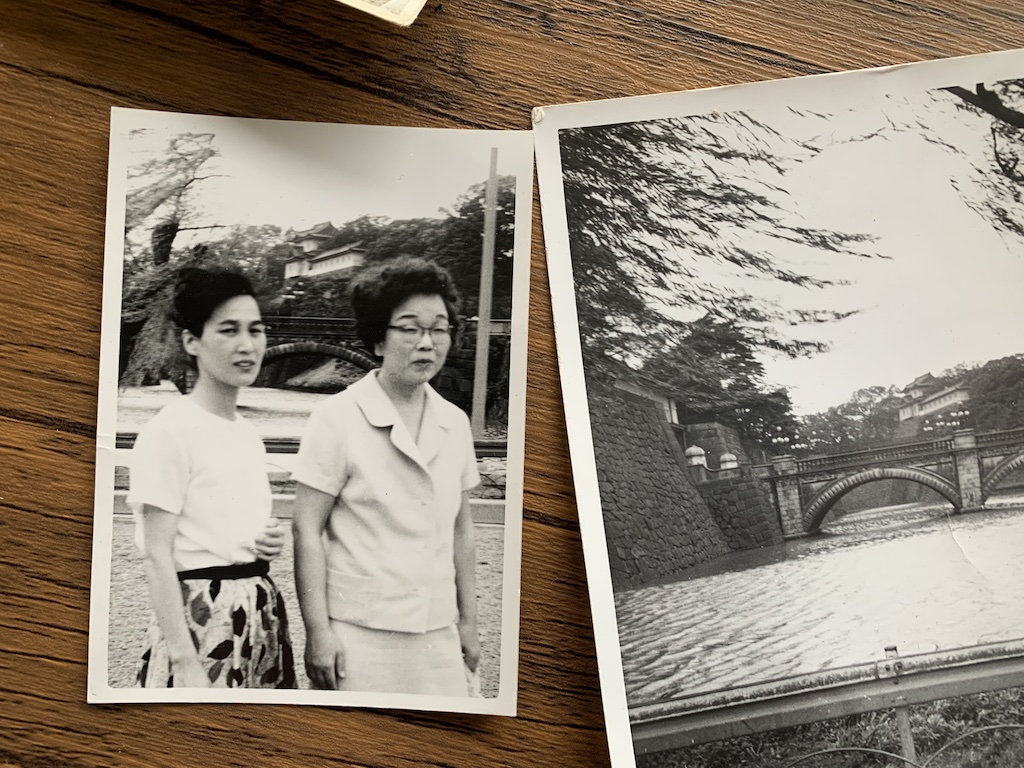
The view is undeniably photogenic. With its calendar-perfect composition of the moat, bridges, stone walls, and watch tower peeking out behind the trees, one can only imagine how many millions of photographs have been taken from this spot over the decades. The exact number is impossible to know but I’d like to show you a few that I’ve come across in photobooks.
視覚的にも、二重橋のある景色は紛れもなくフォトジェニック。お堀、橋、石垣、そして木々の陰から顔を出す監視塔という暦通りの構図で、この場所から何十年もの間、何百万枚もの写真が撮られたことだろうという想像は容易です。
Reappearances of a particular place in photographs is fascinating. Seasons and years and people pass but these places remain- both in the real world and in pictures. Photographs do not exist in a vacuum- each one is contribution to an ongoing, visual conversation held across time and paper. What’s said might not be easily translated into words, but it can be felt deepest through the connections- the sparks- discovered between two or more pictures of the same subject matter.
写真集に特定の場所が再び現れるのは、とても魅力的なことです。季節や年月、人々が過ぎ去っても、その場所は現実にも写真の中にも残っています。写真というものは、一枚一枚が、時間や紙を超えた視覚的な会話に貢献しているのです。同じ題材で撮られた2枚以上の写真の間にあるつながりやスパークを通して、最も深く感じることができるのです。
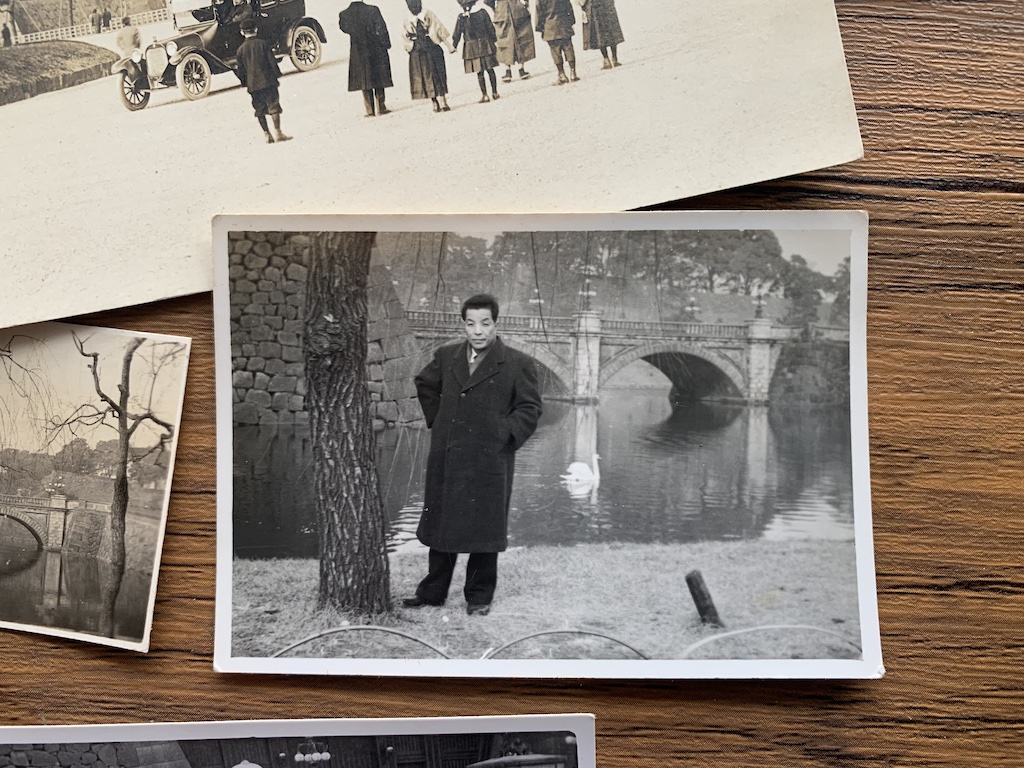
As I said, Nijubashi has long been a place to have one’s photo taken. I’ve been collecting found photos for a few years now and am always pleased to find a “Nijubashi Bridge” snapshot. This genre consists of two types of photos taken there; those of people, and those of the place.
Here are a few of both from my collection:
やはり、二重橋は昔から写真を撮られる場所でした。 私は数年前から拾い物を集めているのですが、「二重橋」のスナップ写真を見つけると、いつも嬉しくなります。これらは、そこで撮られた人物の写真と、場所の写真の2種類で構成されています。 ここでは、私のコレクションから写真集をいくつか紹介します。
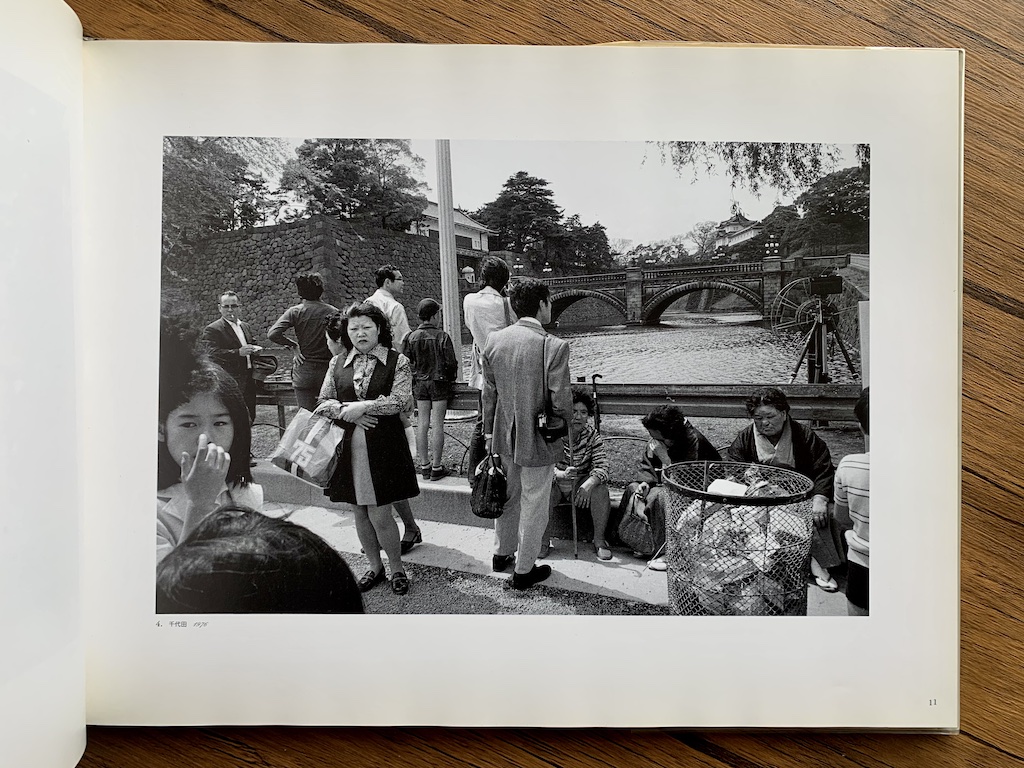
As for photobooks, Hiromi Tsuchida’s picture in Counting Grains of Sand (Tosei-sha, 1990) brilliantly combines people and place- and a sense of humor. The regal view here is populated by tired tourists framed between a trash can and a young woman scratching her nose.
土田ヒロミの写真集『砂を数える』(冬青社、1990年)では、人と場所、そしてユーモアを見事に結びつけています。この堂々たる景色の手前で、ゴミ箱と鼻を掻く若い女性の間に疲れた観光客が挟まれています、すごいね。

Indeed, where people gather, photographers appear. The act of taking a photo can be its own kind of spectacle- or, at the very least, provide a photographer with still, grouped subjects, as seen in Issei Suda’s shot from the late 70s that appears in Fragments of Calm (Tosei-sha, 2013)
人が集まるところには、写真家も現れます。写真を撮るという行為は、それ自体が一種のスペクタクルであり、少なくとも『凪の片』(冬青社、2013年)に掲載された須田一政の1970年代後半のスナップに見られるように、写真家に静止した群像を提供することができるのです。
Nijubashi has also served both as a popular backdrop for history, and for news reports. In this image taken by Shinya Arimoto, Australian newscasters are filmed on the first day of the Imperial Era Reiwa, on May 1, 2019. It appears in his book Tokyo Strut (Zen Foto Gallery, 2022).
二重橋は、歴史の背景として、また報道の背景として、人気のある場所でもあります。有元伸也の『Tokyo Strut』(Zen Foto Gallery、2022年)に掲載されている写真は、2019年5月1日の皇紀礼讃初日に、オーストラリアのニュースキャスターを撮影したものです。
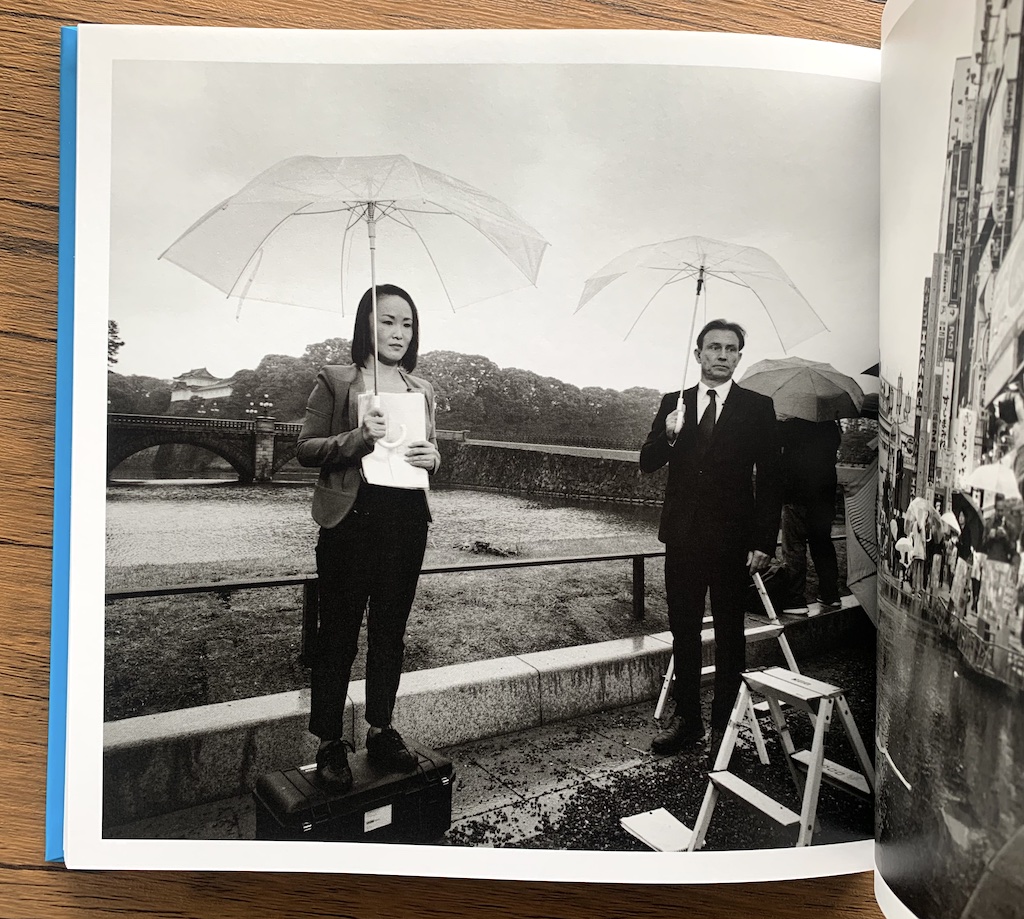
Nijubashi Bridge is a recurring theme in the work of Nobuyoshi Araki.
Its most prominent appearance is the cover of his 1984 book, Tokyo, in Autumn.
二重橋は、荒木経惟の作品に繰り返し登場するテーマでもあります。最も目立つのは、1984年に出版された『東京は、秋』(三省堂)の表紙。
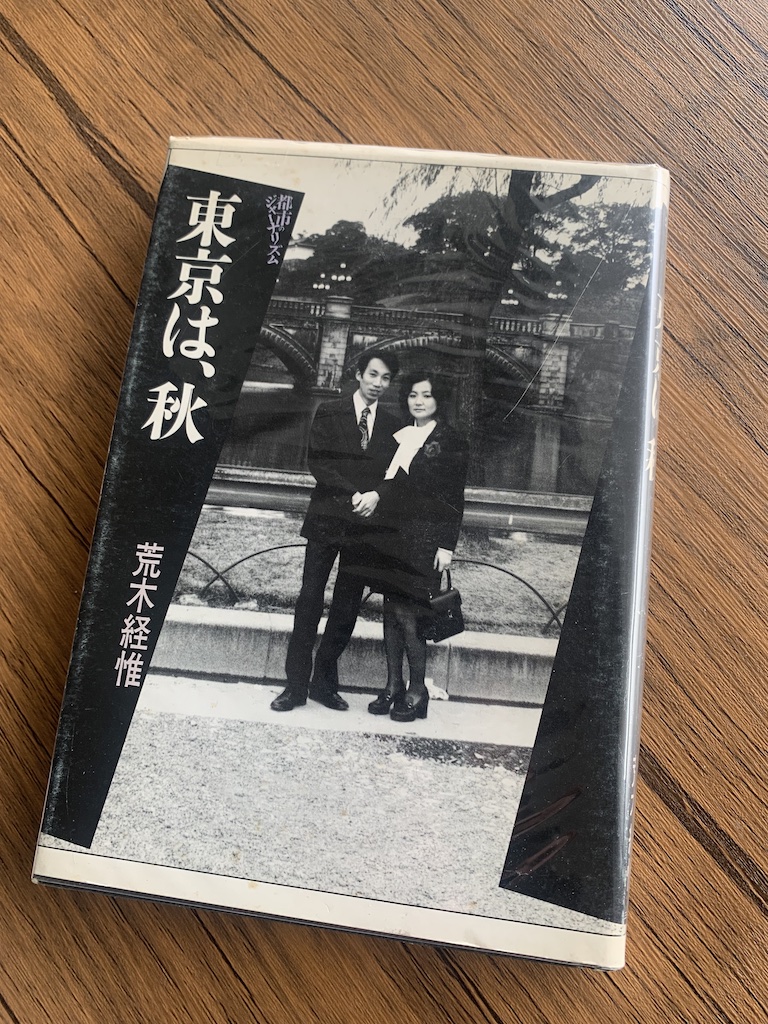
The pictures in this book are accompanied transcripts of conversations Araki and his wife Yoko had while viewing the images. In it, Araki compares Nijubashi as a stage- with Yoko noting that the young couple in it are probably on their honeymoon.
この本には、荒木と妻の陽子が画像を見ながら交わした会話の記録が添えられています。その中で荒木は、二重橋を舞台のように例え、そこに写っている若いカップルは新婚旅行中だろうと陽子は指摘します。
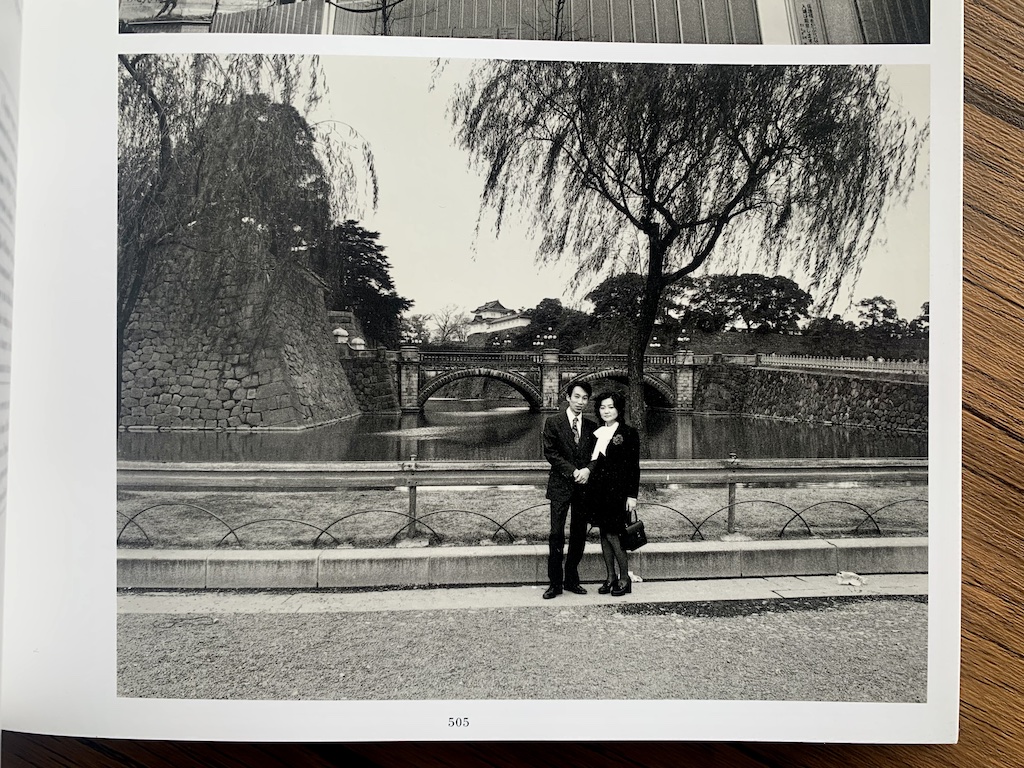
Araki replies that he likes that kind of stuff- “a couple on honeymoon in Tokyo, visiting places like Tokyo Tower and the Imperial Palace”, adding that this the best picture in the book.
荒木は
「新婚旅行では、たいていに皇居とか東京タワーを回る。俺はそうのが好きなんだな。」
「このなかで一番いい写真だよ。」と答えています。
Perhaps, with this picture in mind, he posed for a snap on the same spot in 1985.
おそらく、この写真を意識して、1985年に同じ場所で記念スナップしたのでしょう。

For a man of the Showa age, the date is important. August 15, 1945 was the day the emperor’s surrender speech was broadcast, marking the end of the war.
It’s also worth adding that the stone bridge has the nickname of “spectacle bridge”, since its arches look like a pair of half-submerged glasses. Or, in this case, like Araki’s trademark ones.
終戦記念日の日付なのが面白いですよね。また、荒木のメガネを見ると思い出すのですが、石橋の2つのアーチが眼鏡のように見えることから「眼鏡橋」というアダ名があるそうです。
Moving ahead a few years- in Araki’s Tokyo Summer Story (WIDES, 2003) the palace grounds are seen from his taxi window.
さて、2000年代へ。『東京夏物語』(WIDES、2003年)では、荒木が乗るタクシーの窓から皇居の敷地が見えます。
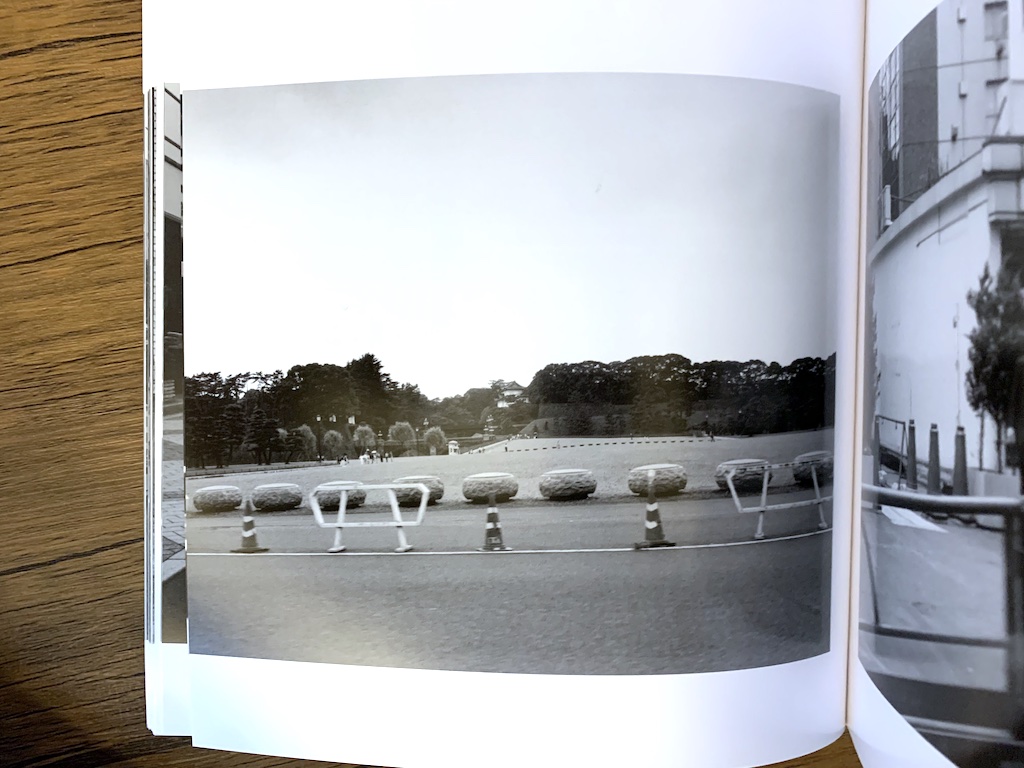
And it appears twice in 2005’s Kotoshi (This Year) - first as reference (Homage? Parody?) to Tokyo, in Autumn:
そして、2005年の『今年』ではこの場所が2回登場します。まずはペンタックス67で撮った記念写真。これは『東京は、秋』へのオマージュか? パロディー?
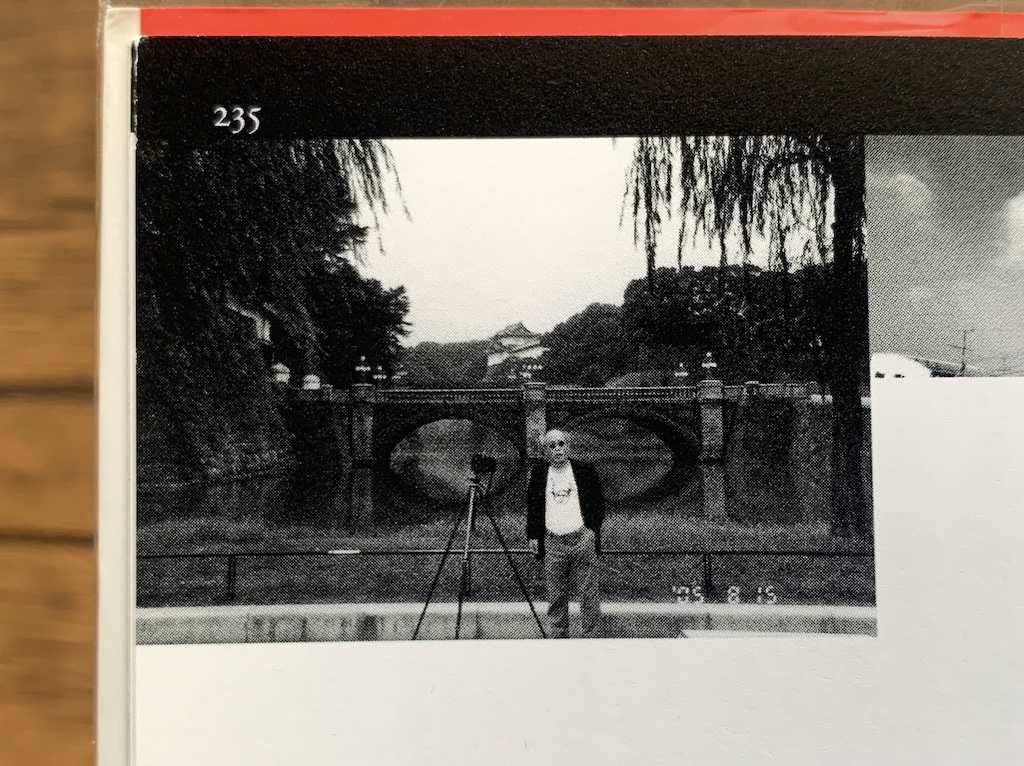
And then, a few pages later, date-stamped (and printed quite small).
そして、数ページ後に終戦記念日の日付が現れてくるのです。
The last image of the bridge that I’m aware of in Araki’s books is this brilliant one from Tokyo Radiation (WIDES, 2010). It was presumably taken from a taxi, obviously with a longer focal length. The visual compression of the crowd adds a touch of poignant distance, to my eye.
私が知る限り、荒木の著書で最後に撮影された橋の画像は、『東京ホウシャセン』(WIDES、2010年)でのこの見事な一枚です。タクシーから撮影されたと思われ、明らかに焦点距離が長い。群衆の視覚的な圧縮が、私には痛烈な距離感を与えているように見えます。
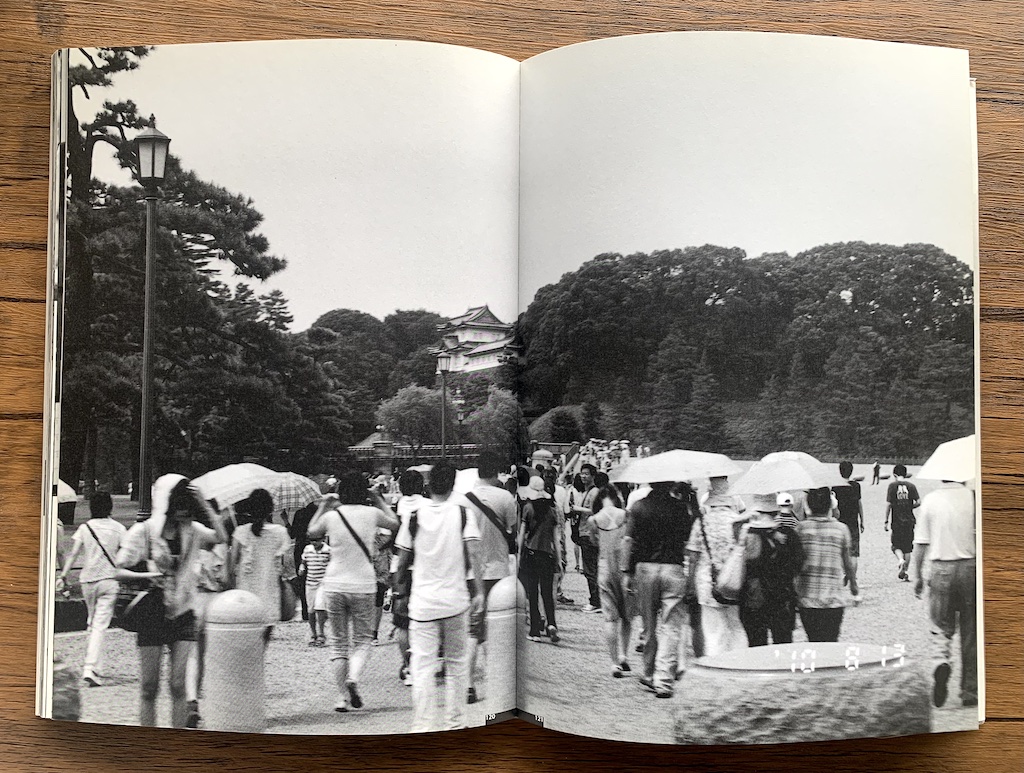
Lastly, having lived and photographed in Tokyo for many years, I’ve likewise photographed this scene many times.
On an early, quiet summer day in 2014 I saw an out of town couple standing in front of the same willow as Araki’s cover couple did in the mid 1970s. With his picture in mind I raised my camera to my eye. Was it my turn to add to the conversation? Instead of posing for a photo, these two, with their compact digital camera, were taking their own pictures. Captured in photographs across forty years, these two couples have a connection to each and every person who’s been photographed before this bridge.
最後に、長年東京に住んで撮影してきた私は、同じようにこの光景を何度も撮影してきました。

2014年の初夏の静かな日、荒木さんが表紙を飾ったカップルと同じ柳の樹の前に、町外れのカップルが立っているのを見かけました。 荒木さんの写真を思い浮かべながら、私はカメラを目前に掲げました。カシャ。今度は私がここまで営まれてきた「写真的会話」を深める番なのでしょうか。コンパクトデジタルカメラを手にした二人は、ポーズをとるのではなく、自分たちで写真を撮っていた。 40年の時を超えて写真に収められたこの2組のカップルは、この橋の手前で撮影された人たち一人ひとりとつながりをもっている気がします。
Photography is really about threading a ribbon of silver (or data) through life, time, and place.
そう。写真とは、人生、時間、場所に銀(またはピクセル)のリボンを通すこと。たまらないですね。
The official Chiyoda ward webpage for Nijubashi:
https://visit-chiyoda.tokyo/app/en/spot/detail/242
千代田区観光協会「二重橋」:
https://visit-chiyoda.tokyo/app/spot/detail/242
The Nijubashi bridge page on oldtokyo.com:
https://www.oldtokyo.com/nijubashi-imperial-palace/
 26 Duets? Duels? Near-overlaps of time and Space across Tokyo. 東京の時間と空間が重なり合う写真集ツアー
2025/04/04
26 Duets? Duels? Near-overlaps of time and Space across Tokyo. 東京の時間と空間が重なり合う写真集ツアー
2025/04/04
 25 Naoki Ishikawa "TOKYO The City Where I Was Born" 石川直樹『東京 ぼくの生まれた街』
2024/01/05
25 Naoki Ishikawa "TOKYO The City Where I Was Born" 石川直樹『東京 ぼくの生まれた街』
2024/01/05
 24 山内道雄 Michio Yamauchi『TOKYO UP CLOSE』
2023/10/20
24 山内道雄 Michio Yamauchi『TOKYO UP CLOSE』
2023/10/20

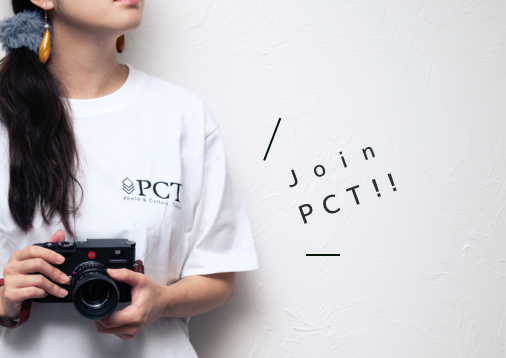
PCT Membersは、Photo & Culture, Tokyoのウェブ会員制度です。
ご登録いただくと、最新の記事更新情報・ニュースをメールマガジンでお届け、また会員限定の読者プレゼントなども実施します。
今後はさらにサービスの拡充をはかり、より魅力的でお得な内容をご提供していく予定です。
 「Photo & Culture, Tokyo」最新の更新情報や、ニュースなどをお届けメールマガジンのお届け
「Photo & Culture, Tokyo」最新の更新情報や、ニュースなどをお届けメールマガジンのお届け 書籍、写真グッズなど会員限定の読者プレゼントを実施会員限定プレゼント
書籍、写真グッズなど会員限定の読者プレゼントを実施会員限定プレゼント